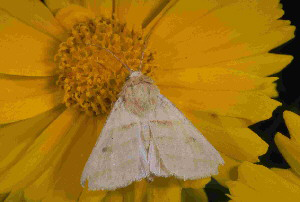Corn Earworm Insect Trap Data
The corn earworm is also know as the Soybean Podworm and Tomato Fruitworm. The adult moths are greenish gray or a light grayish brown with dark-gray irregular lines on the forewings. The irregular lines are often a shade of olive-green. Hind wings are white with some dark spots or irregular markings. Night flying, the corn earworm moth has a wingspan of 1½ inches. The first generation of corn earworm moths emerges as early as late-March in Kentucky. There are generally four generations each year, however, overlap is great and adult moths that can lay eggs may be present in significant numbers throughout most of the growing season.

Corn earworm moth
For additional information on corn earworm as a pest of sweet corn see ENTFACT-318 Corn Earworm Management in Sweet Corn, Kentucky Sweet Corn Insect IPM Scout Manual and EntFact 302-Sweet Corn Pests. Details on this insect as a pest of soybeans can be found in Soybean Podworm Scout Info Sheet and EntFact 144-Soybean Podworm in Kentucky Soybeans.
To view the data that includes temperature and accumulated degree days you will need Microsoft Excel®.
University of Kentucky Research Center, Princeton, KY
| 1992 | 1993 | 1994 | 1995 | 1996 | 1997 |
| 1998 | 1999 | 2000 | 2001 | 2002 | 2003 |
| 2004 | 2005 | 2006 | 2007 | 2008 | 2009 |
| 2010 | 2011 | 2012 | 2013 | 2014 | 2015 |
| 2016 | 2017 | 2018 | 2019 | 2020 | 2021 |
| 2022 | 2023 | 2024 | 2025 |
University of Kentucky Spindletop Farm, Lexington, KY
| 2007 | 2008 | 2009 | 2010 | 2011 | 2012 |
| 2013 | 2014 | 2015 | 2016 | 2017 | 2018 |
| 2019 | 2020 | 2021 | 2022 | 2023 | 2024 |
| 2025 |
Insect trap data are provided for educational purposes only. Weather data provided by the University of Kentucky Agricultural Weather Center and Kentucky Mesonet. Weather data if used for legal purposes must be certified by NCDC, National Climate Data Center.


